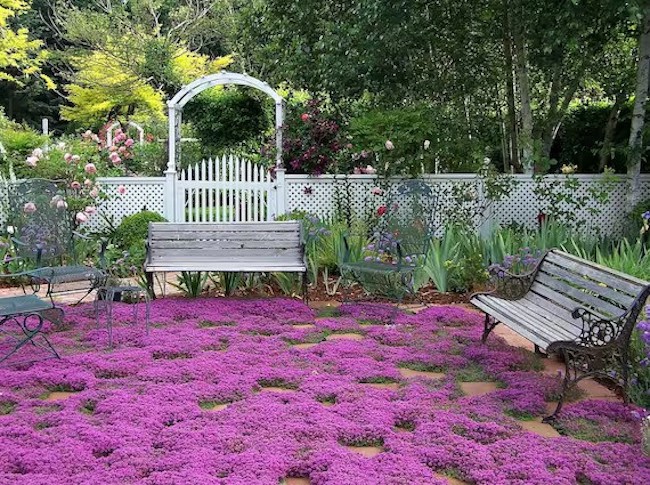Transform Your Garden with Creeping Thyme Magic! Grow and Care for Creeping Thyme
“Transform Your Garden with Creeping Thyme Magic! 🌿✨ Dive into our must-know tips for growing and caring for this enchanting plant. Get ready to unleash your inner garden guru!
The Mother of Thyme
Let’s talk about creeping thyme, also known as ‘Mother of Thyme’! It’s a type of thyme that’s super easy to grow and spreads out nicely. You can use it instead of grass in your yard, or plant it between stepping stones or bricks to make a cool living patio. Now, let’s find out how to take care of this awesome plant!

Unveiling the Green Magic: Fascinating Creeping Thyme Facts!
Meet Thymus praecox, also known as creeping thyme! It’s a small perennial plant that loves to grow in zones 4 to 9, and it’s pretty easy to take care of. This little guy stays green all year round and has tiny, fuzzy leaves. It spreads out like a cozy carpet, filling in spaces and making the ground look lush.
You can eat creeping thyme, just like other types of thyme. It tastes and smells a bit like mint when you crush it or use it for tea. When it’s time to harvest, you can either pluck the leaves off the stems or dry them by hanging them upside down in a cool, dark place.

For the best flavor, pick creeping thyme in the morning when its oils are at their strongest. Plus, here’s a cool fact: deer usually stay away from this plant, so it’s great for areas where deer roam. And it’s tough enough to handle kids running around on it, so it’s perfect for places with lots of foot traffic.
When creeping thyme blooms, it’s like a buffet for bees! They love the flowers, and the pollen they collect gives honey a unique flavor. So, if you’re into helping out the bees, this plant is a great addition to your garden.
Planting Perfection: Mastering the Art of Creeping Thyme Planting!

Growing creeping thyme is easy-peasy! It’s like the chillest plant ever because it’s cool with all kinds of soil and light situations. It prefers soil that’s not too soggy but not bone dry either. Basically, just keep it moist, and it’ll be happy.
Oh, and it’s not picky about pH levels in the soil. Neutral to slightly alkaline works just fine for it. You can start creeping thyme from cuttings or divisions, or just grab some from the nursery. If you’re starting from scratch, plant the seeds indoors in spring or outside after the frosty danger has passed.
When you’re planting, give each creeping thyme buddy some space to spread out – about 8 to 12 inches apart. And don’t forget to give it a little haircut in the spring to keep it looking neat. If you want, you can trim it again after its cute little white flowers are done blooming for extra shaping. Easy peasy, right?
Propagating Creeping Thyme Like a Pro

- Grab some sharp scissors or pruning shears and snip a 1-inch piece of stem.
- Strip off the lower leaves so you have a clean stem.
- Stick that stem cutting into a small pot filled with well-draining soil.
- Give it a gentle drink of water, just enough to moisten the soil.
Here’s how to propagate creeping thyme like a pro: In about two to three weeks, you’ll see roots starting to grow. Once they’re nice and established, you can move your new creeping thyme plants to their own pots. Easy-peasy!
Creeping Thyme UPDATE in 3rd Year

Check out my Creeping Thyme after three years! I’m totally smitten with how awesome it’s been – it’s low-key, handles dry spells like a champ, can take the heat, and stays green all year. Plus, it’s like the glue holding my garden together!
Oh, and here’s a cool trick: I’ll show you how to split it up to make even more plants for free!

